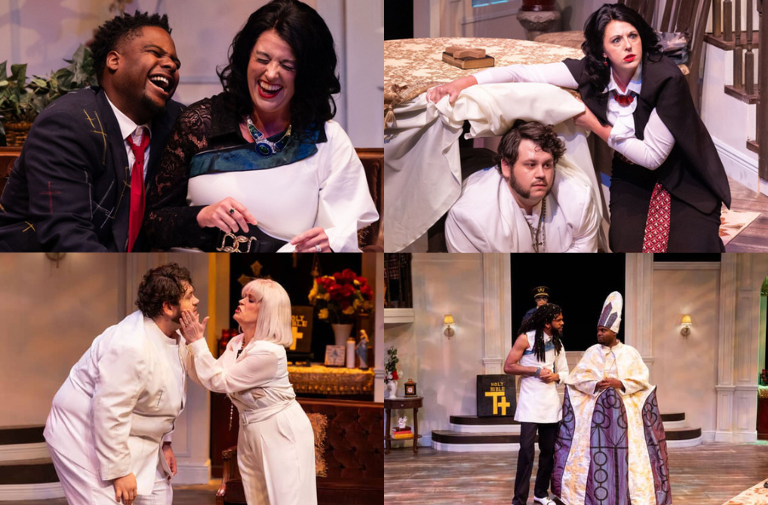Holy Hypocrisy, Fresh Laughs: FAU’s ‘Tartuffe’ Opens The Season With Bite | Review
“Tartuffe” opened FAU’s Theatre & Dance 2025-26 production season, and the company set the bar high for a successful year. The production takes a modern spin on Molière’s timeless comedy “Tartuffe,” and the choice pays off. The audience follows the titular character, Tartuffe, a con artist posing as a “holy man” who takes advantage of the aristocratic family that takes him in, hiding behind his supposed piety. Between the speeches of each character, their costumes, and the set design, the production allows the problems of the world in “Tartuffe” to come to life in ways that feel immediate and recognizable, especially when compared to modern politics. Read our full overview and preview here. Modern Spin | 5 / 5 The show’s modern twist on the original classic makes the text easier to understand without sanding down the edge of Molière’s satire. By drawing clear comparisons to current U.S. politics, the updates make consistent sense and take a sharp jab at those who hide behind hypocrisy and religion. The lesson is pointed but not preachy: do not allow religion—your own or anyone else’s—to cloud judgment or excuse harmful behavior. The dramaturgical choices, from language rhythm to visual motifs, work in concert to keep the audience anchored in the plot while highlighting how old patterns of manipulation repeat in contemporary life. The clarity of the throughline means first-time viewers can track every scheme while long-time comedy fans catch the layered ironies. Acting | 5 / 5 As someone who has been to shows at award-winning theaters with star actors, including the Kravis Center, the Broward Center for the Performing Arts, and The Wick Theatre, I was immersed in the acting of both the undergraduate and graduate student performers and rarely felt like I was at a student-run production. Jonathan Palmer (Tartuffe) does an excellent job showboating the character’s hypocrisy and performative piety, shifting from silky charm to sanctimonious thunder in the space of a line. Paige Rogers (Elmire) delivers with precision and control, fully immersing and mesmerizing in each moment of stage time; her timing helps land both the comedy and the danger in Tartuffe’s advances. Together, Palmer and Rogers execute their “battle of wills” with snap and wit before several passionate moments that escalate the stakes and the laughs. Gustavo Garcia (Orgon) and Jayden Terrell (Damis) project fiery conviction, selling their characters’ anger and dedication so the family’s unraveling feels earned rather than convenient. Altogether, each actor executes their role with intelligence and fervor, and the ensemble consistently finds the heat in the argument while staying truthful to the scene. While every actor must remember lines, the cast’s command of fast-paced speeches and older diction is worth singling out; the delivery is crisp, the diction is clean, and the momentum never stalls. The result is a show that plays with professional confidence, at a pace that keeps the audience leaning forward. Costumes | 3.5 / 5 The costumes are fully expressive and frequently amusing, especially Tartuffe’s costume change into a “holy priest,” which reads instantly and adds a comic jolt. For example, Jayden Terrell’s (Damis) look featured two layers of jeans with a T-shirt and a cropped white hoodie, suggesting a character both armored and impulsive, while Jakari Dozié’s (Cléante) ensemble included a tie knotted around the arm, a white tank top, a Scottish-style skirt, and an old-fashioned men’s jacket drooping off one shoulder. The overall effect broadcasts that this household sits slightly askew from normal, an aesthetic that complements the play’s thematic interest in appearance versus reality. The approach, however, is a double-edged sword. Some characters’ costumes are less expressive than the bolder looks, which can flatten their stage presence by comparison. At times, the maximalism becomes distracting; the sheer variety of silhouettes and textures can pull the eye away from the actors’ line delivery and make the plot a touch harder to follow along with, especially for audience members new to the text. That said, the designs are executed with care, they add a vivid layer of world-building, and each choice plays a unique role in bringing “Tartuffe” to life. If the palette and period-blending were reined in slightly or balanced more evenly across the ensemble, the storytelling clarity would likely improve without sacrificing flair. Stage/Set Design | 4.5 / 5 Following suit with the costumes, the set design immerses the audience in the world of “Tartuffe” while signaling that something is off. The production uses a single primary stage picture with small but meaningful changes throughout the show, and it tells the story with confidence. Crooked and bent lights, askew chandeliers, and discreet religious motifs tucked across the playing space suggest a household where devotion has tipped into idolatry, telegraphing the themes before a word is spoken. Characters walk out of a painting on the wall, and a closet with a hidden door becomes a practical running bit that also advances the plot. A personal favorite element is the religious altar, whose swaying lights and color changes across key scenes feel like a barometer for Tartuffe’s influence. The lighting design does heavy lifting, marking rooms, shifting tone, and underlining reversals—and, paired with the set’s elastic architecture, helps sustain pace. Casey Venema (Dorine) pulling popcorn out of the couch adds another level of humor and grounds the satire in lived-in domestic detail. If there is a limitation, it is that the set relies a bit more on lighting than on physical reconfiguration to create new spaces. Given that the costumes blend time periods, some characters in jeans and hoodies, others in suits or hybrid formalwear, the stage picture might have benefited from a few more tactile elements bridging eras so the visual language reads even more cohesively. Still, the design choices effectively support the performances and the story’s “moral chess game.” “Tartuffe” | 4.5 / 5 FAU’s Theatre & Dance is not your run-of-the-mill university theater. The company executes at a high level, with little room for improvement in the areas that most matter to audiences: clear storytelling, precise acting, and a confident directorial hand. This special rendition of “Tartuffe” is well done—smart in its updates, sharp in its satire, and generous in its comedy. Even with occasional distractions in the costume palette and a set that could blend its time cues just a touch more, the production remains engrossing, energetic, and accessible for first-timers and Molière fans alike. As a season opener, it announces ambition. As a night at the theater, it delivered. Sign up to receive the OutFAU newsletter here
Latest Owl Central News
- NAMIWalk2025 UpdatesGood afternoon everyone, I hope you are all doing well. For those of you who stopped by our table this week, we were very happy to see you, and we are excited to walk with you this year. For those of you who did not, we are doing the NAMIWalk2025 this year in a collaboration event with FAU Thrive, and we would love to have you walk with us. Attached to this announcement will be a QR code for our walk team. We would love for you to join us! The walk this year will be at 8 am at John Prince Park on Saturday, November 1st. On Monday, the 27th, we plan to share more information about the exact details. For those of you attending, we ask that you fill out the travel waiver, which will be in the documents section of our club, and send it to the following emails: lfaerman@fau.edu, dvanpelt@fau.edu, and namifaujupiter@gmail.com. In addition, if you are looking for people to carpool with/ are able to carpool others to the event, please reach out to us at namifaujupiter@gmail.com. Please share this with all of your friends around campus in case they are walking and did not see the announcement. Thank you all so much, and we look forward to walking with you this year! My best, Sam Mittleman
- Personal Trainer Position [Applications Open]The personal trainer must be able to develop and implement exercise programs that are safe, effective, and appropriate for individuals who are apparently healthy or have medical clearance to exercise. Personal trainers must also be able to conduct health history interviews, administer proper assessments, understand human anatomy and functional exercise concepts, empower individuals, design workout programs for clients, educate, and assist clients in reaching their goals. Certification required; any of the following are acceptable: ACE, NASM, NSCA, ACSM, or NCSF. This position will work approximately 15 hours per week and must be willing to do some early mornings, nights, and weekends (as needed) to cover client needs. If you are interested in applying for this position, please do so at the following link: https://fau.wd1.myworkdayjobs.com/en-US/FAU/job/Personal-Trainer_REQ20976 STUDENTS ONLY. Applications close at 11:00pm on December 2nd, 2025. If you have any questions regarding the position, please email Jack Quint at quintj@fau.edu.
- NAMI on Campus & FAU Thrive CollaborationGood morning everyone, I hope you're all doing well! I have some exciting news to share on NAMI on Campuses most recent collaboration. NAMI on Campus and FAU Thrive are excited to announce our collaboration for the 2025 NAMIWalks! This year, we’re walking together on Saturday, November 1st at John Prince Park- Eric Call Pavilion to show that mental health matters. College life can be exciting, challenging, and everything in between. That’s why we’re joining forces to take real steps toward breaking the stigma around mental health and reminding one another that no one has to go through it alone. Together, we can make a difference one step at a time. Here’s how you can get involved: Join our FAU walk team and walk with us to support mental health awareness. Donate to our team page. Every contribution goes directly to NAMIWalks, helping fund mental health programs and advocacy across our communities. Spread the word! Invite your friends, classmates, and professors to walk or donate. Team Page Link: https://www.namiwalks.org/teams/Thrive-on-Campus-2025 Thank you for supporting FAU Thrive and NAMI on Campus. We hope to see some of you there!
- OutSFL at FAU: The First Amendment IssueWe the People… Know Our Rights. Introducing OutSFL at FAU's First Amendment Issue—a full-throated defense of Our Rights. Our Voices. Our Fight to Be Heard. This month, we’re shining a light on the freedoms that make our words, protests, and presses possible. What Is the First Amendment? The Bill of Rights guarantees five core freedoms—speech, press, religion, assembly, and petition—forming the foundation of democracy. ✝️ Pray, Don’t Preach. How the separation of church and state protects personal faith and public education alike. Incitement, Threats, Defamation. Where free speech ends and real harm begins—exploring campus cases and legal limits. Daring to Publish. From underground zines to student papers, press freedom thrives when students question power. ✊ Peaceful, Not Silent. Protests, marches, and movements—the right to assemble still fuels modern activism. How We Make the Government Listen. From petitions to policy change, speaking out still moves the needle. BLISSS & Mingle. BLISSS and SG Global Programming united students for an evening of resources, community, and empowerment. ️ LGBTQ+ Tools That Work. PRISM’s Resource Hub connects students to testing, safer-sex tools, and LGBTQ+ rights education. OutFAU Scores Big! Seven Sunshine State Awards. Three first-place wins. Student journalism is alive, fearless, and thriving. OutFAU is hiring paid designers & contributors — join the team rewriting the script. Application is in our bio! Check out the issue on Instagram here. Read the digital issue here.
- BLISSS & Mingle: Networking, Resources, Bingo To Bolster ‘Success’ For FAU’s Queer CommunityDozens of students and community members came out for BLISSS' 2nd Annual BLISSS & Mingle. BLISSS (BIPOC LGBTQIA+ Individuals Seeking Safe Spaces) partnered with Student Government Global Programming to host the event in the Boca Raton Student Union on Monday, October 6. In an interview, BLISSS Vice-President Tyler Doll stated the purpose of the evening was to inform students, especially queer students, “about the resources they have available to them on and off campus.” Doll went on to elaborate that it is important for students, especially LGBTQ+ students, to be “successful.” The evening offered complimentary food and drink while students were able to network with and learn about a coalition of organizations, including nonprofits PRISM, Compass LGBTQ+ Community Center, SAVE LGBT, and student organizations Lavender Alliance, College Democrats at FAU, and OutFAU. While learning about resources, participants were given a bingo card to circulate around the room, encouraging them to learn more about each person in attendance. When asked what a perfect end of the night would look like, Doll solidified that BLISSS' goal for the night was to connect students to resources. “Just to know that at least one person has walked out of BLISSS & Mingle knowing that they have gotten some new resources that they will be using to their advantage,” said Doll.
- Anti Hazing Event informationThe Anti Hazing event organization will be on September 25th on Thursday at 6-7pm at the Student Union, Barry Kaye Auditorium. Officers are encouraged to come, other club members are as well too! as your president, I will be there! see ya then! as well, please look out for when the first unofficial screening is for Moonlight. I will send an old school email shortly, Monday after 5pm President, Owl Film Club













